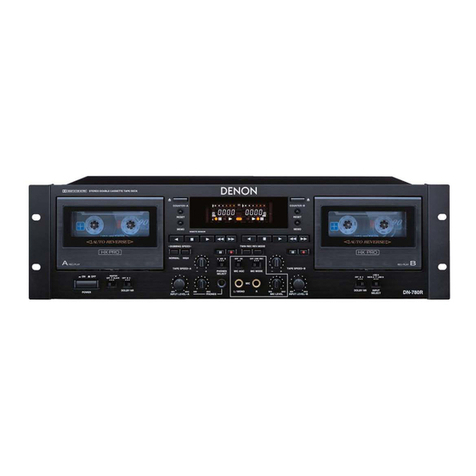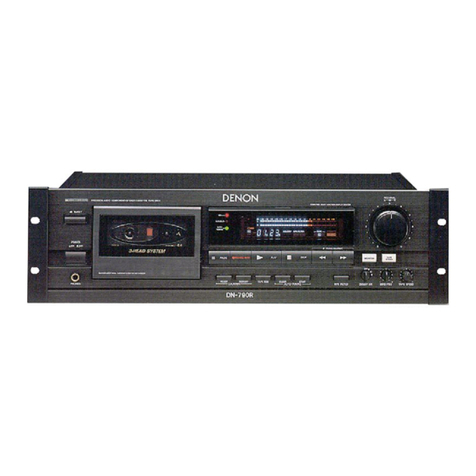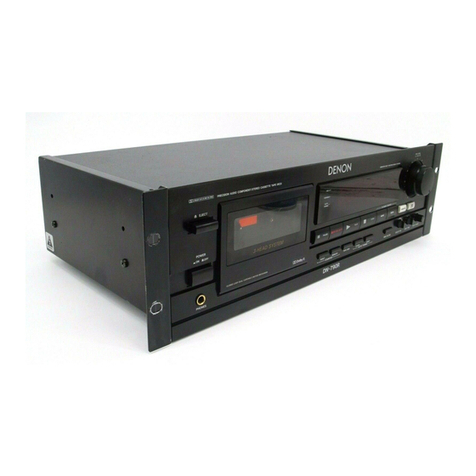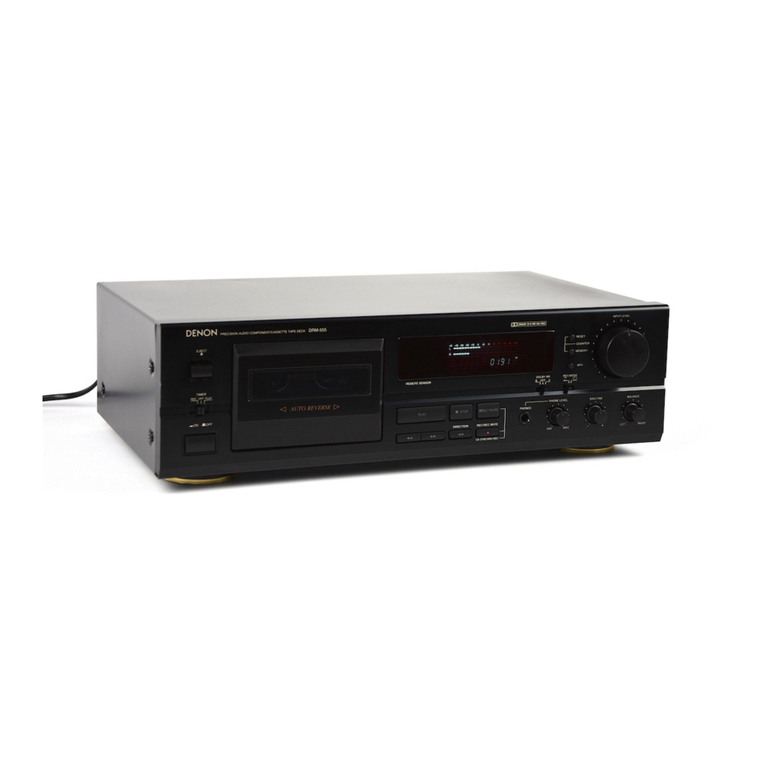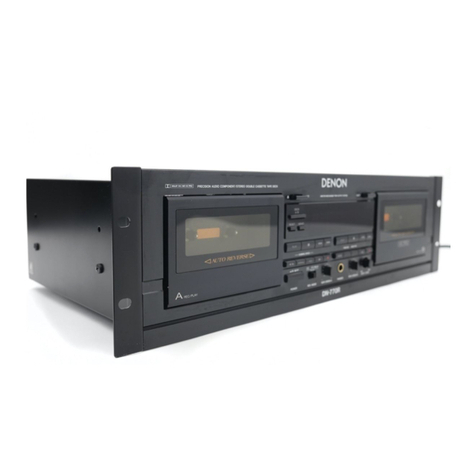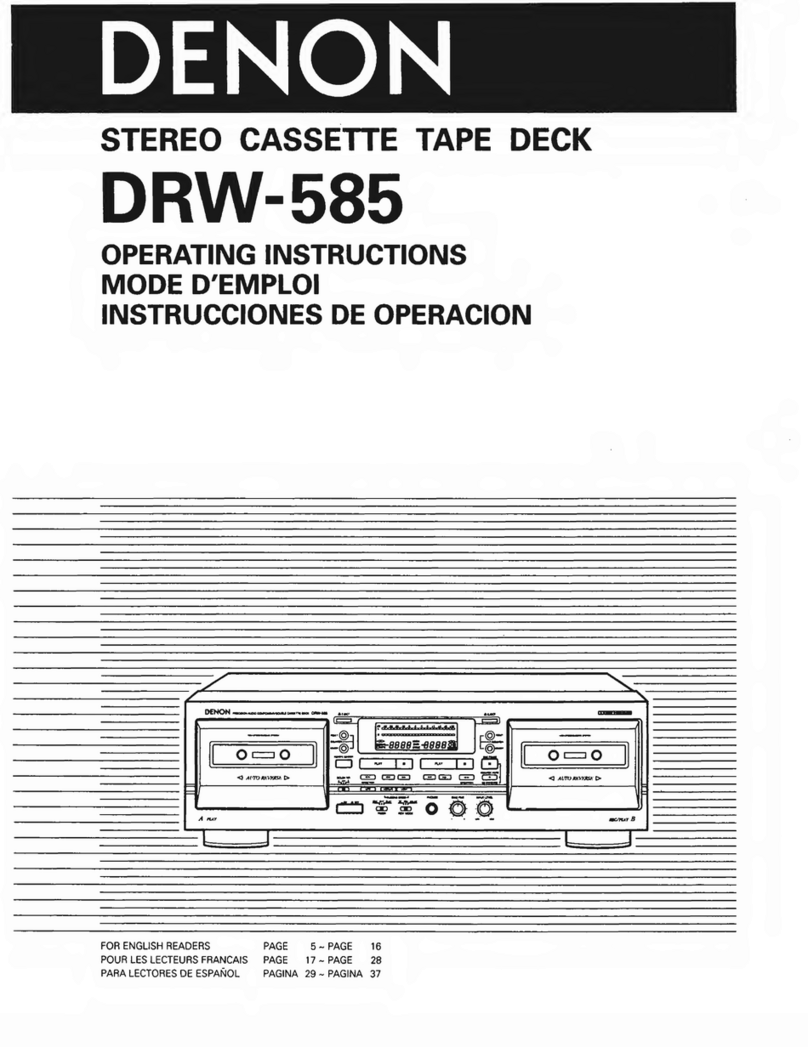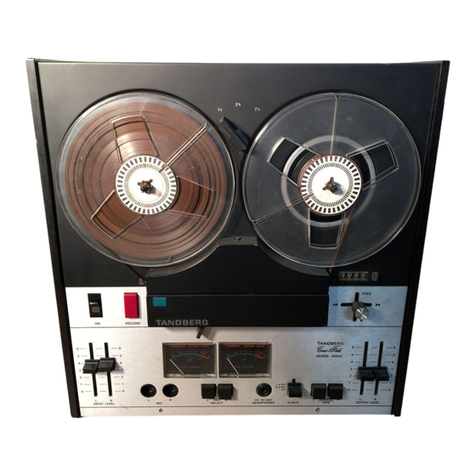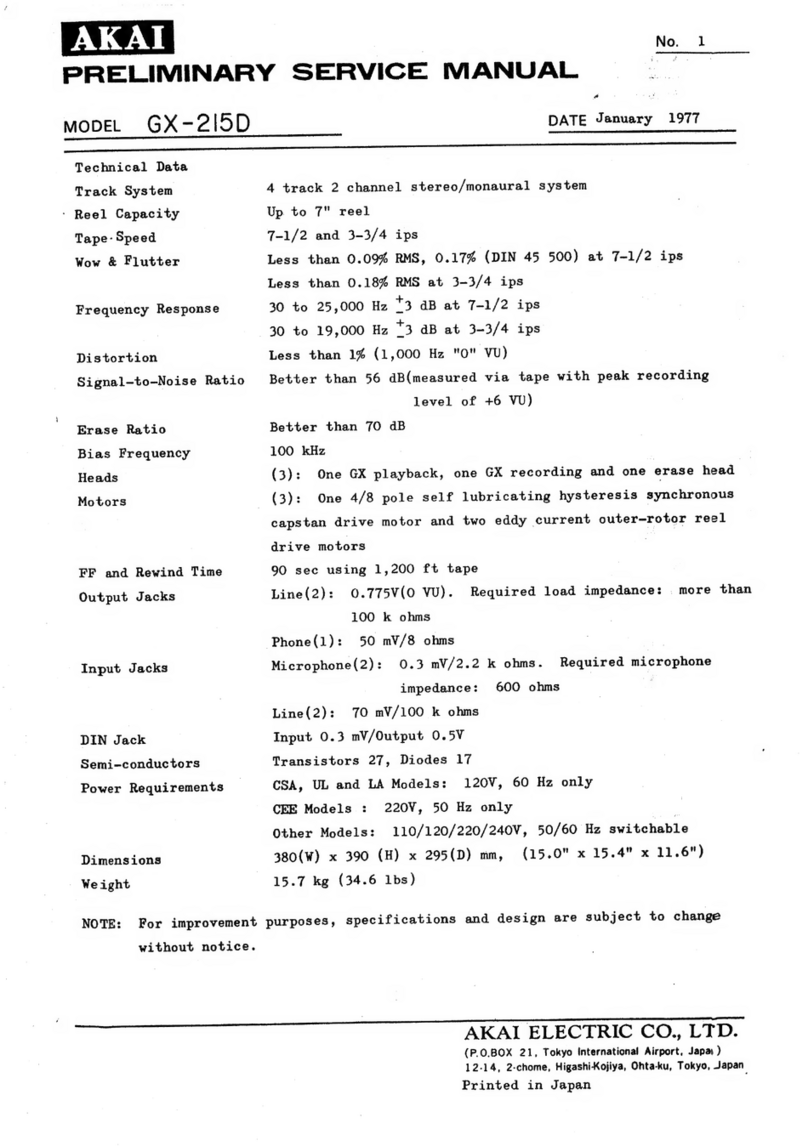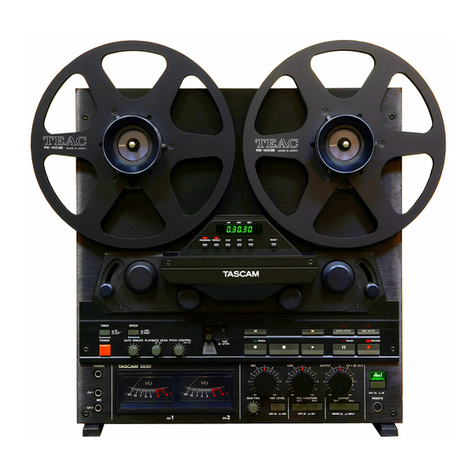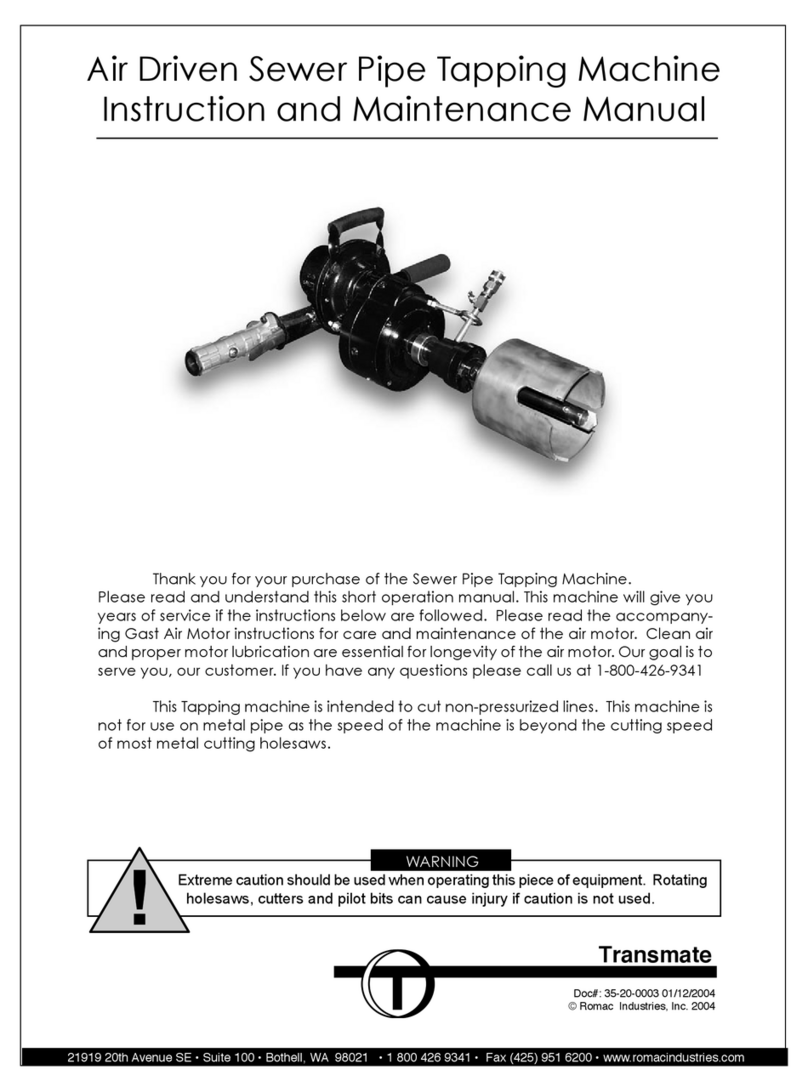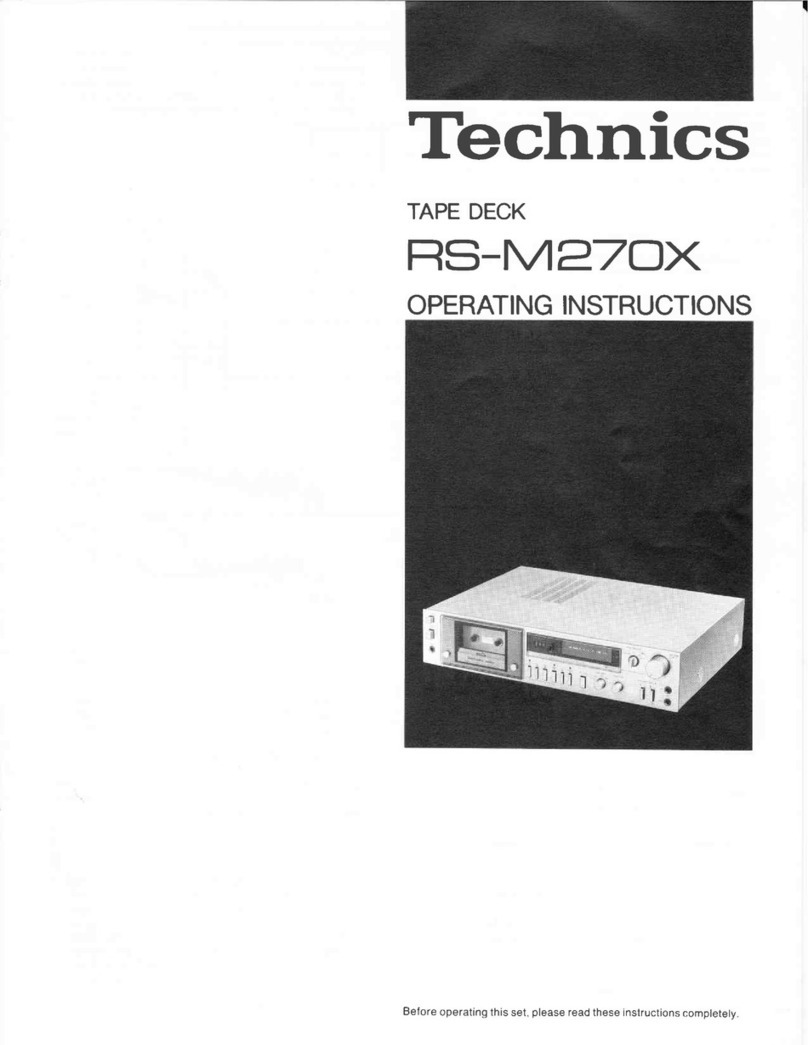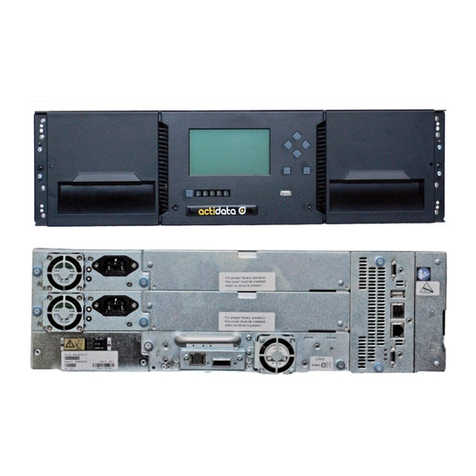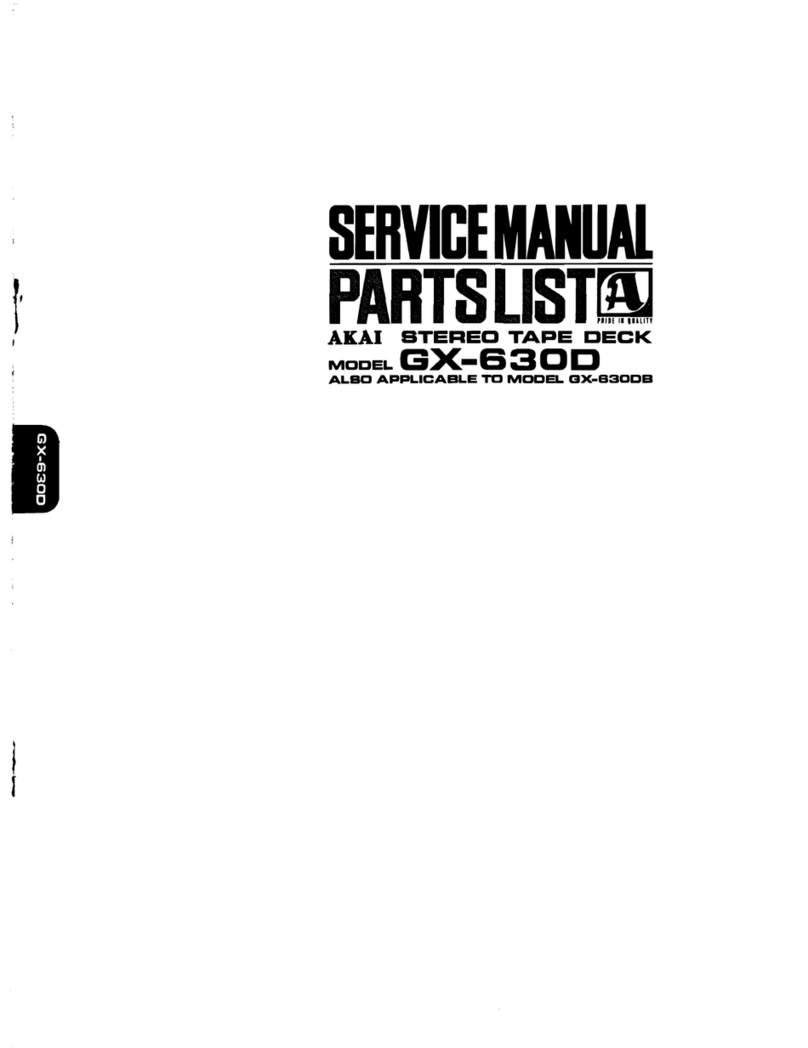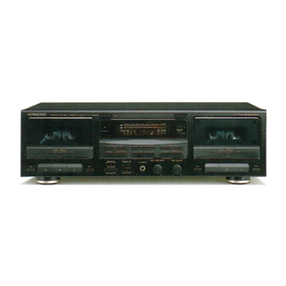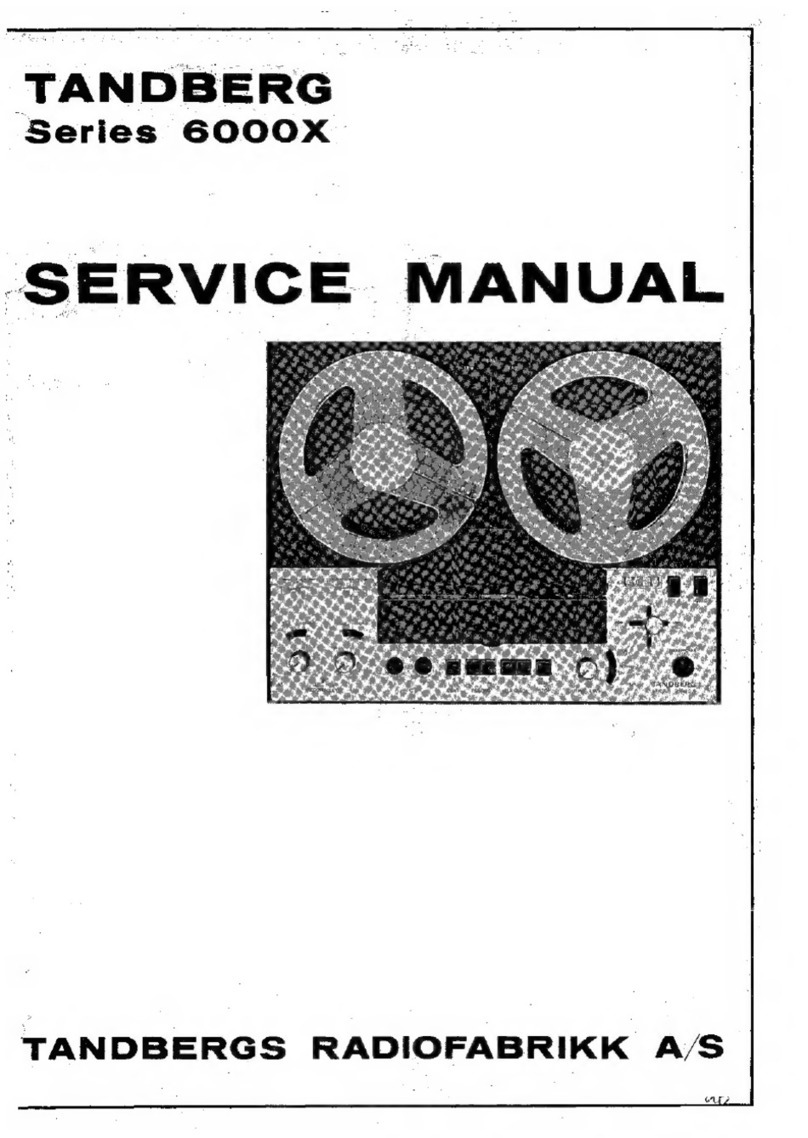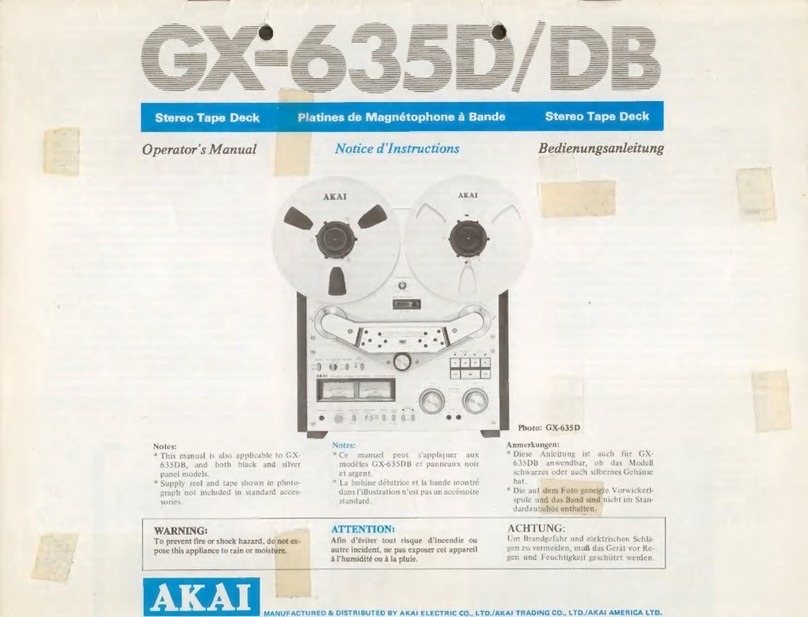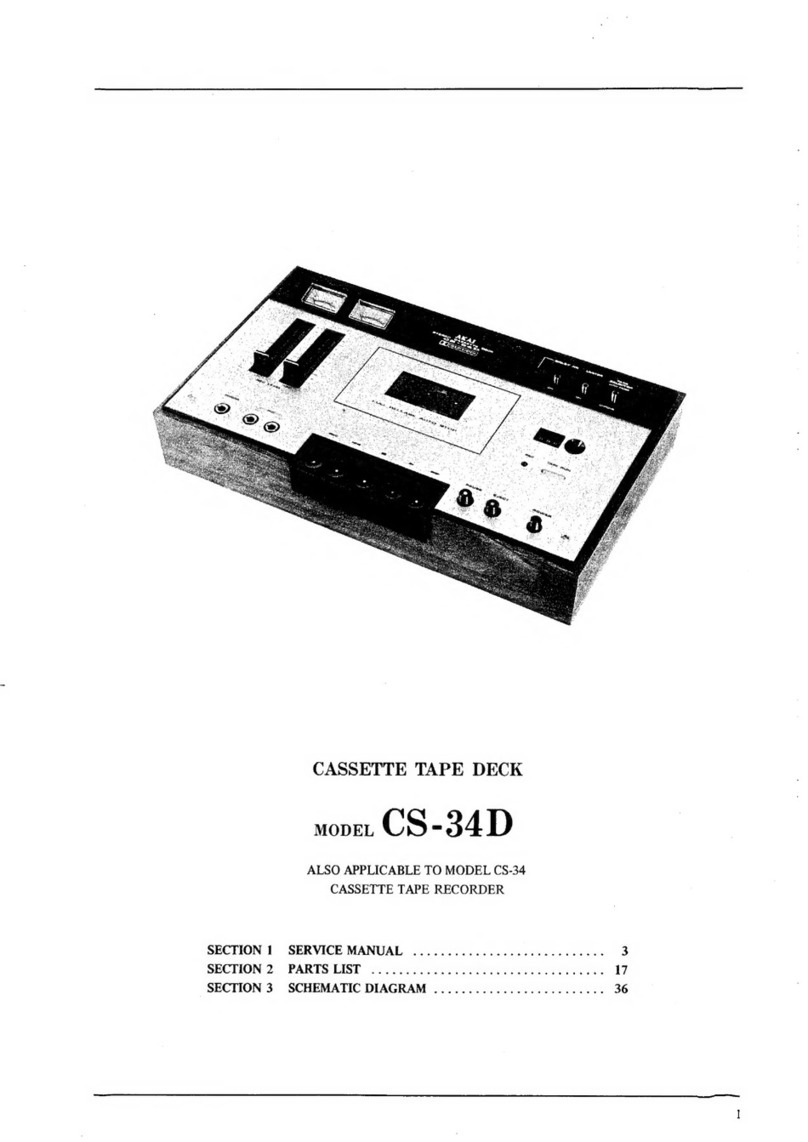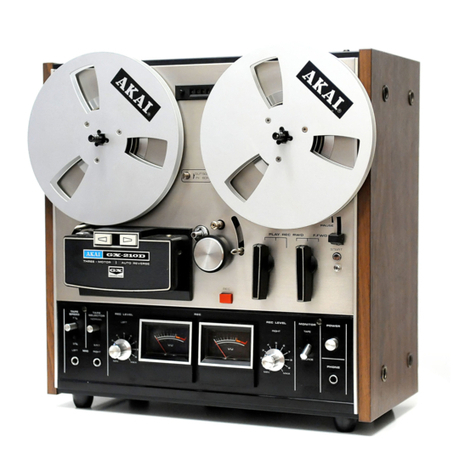Denon DRM-800A User manual

Hi-Fi Component
SERVICE MANUAL
STEREO CASSETTE TAPE DECK
IVIODEL DRM-800A
I
ITABLE OF CONTENTS I
OPERATING INSTRUCTIONS 2 - 11
SPECIFICATIONS 11
BLOCK DIAGRAM 12
LEVEL DIAGRAM 13
DISASSEMBLY INSTRUCTIONS 14 - 15
ADJUSTING AND CHECKING THE MECHANISM SECTION 15 - 17
ADJUSTING THE ELECTRICALSECTIONS 17- 19
PARTS LIST OF EXPLODED ViEW 20
EXPLODED VIEW OF CABINET AND CHASSIS GROUP _ 21
PARTS LIST OF 4U-1817/4U-1823/MECHANISM EXPLODED ViEW 22
EXPLODED VIEW OF MECHANiSM _ 23
PARTS LIST OF 4U-181 6 24
WIRING DIAGRAM/BUNDLE DIAGRAM _ 25
SCHEMATIC DIAGRAM 26-27
PW.BOARD OF 4U-1816 28
P.W.BOARD OF 4U-1817/4U-1823 29
SEMICONDUCTORS 30
NIPPON COLUMBIA CO.,LTD.

IMPORTANT TO SAFETY
WARNING:
TO PREVENT FIRE OR SHOCK HAZARD, DO.
NOT EXPOSE THIS APPLIANCE TO RAIN OR
MOISTURE.
CAUTION:
1. Handle the power supply cord carefully
Do not damage or deform the power supply cord. If it
is damaged or deformed, it may cause electric shock
or malfunction when used. When removing from wall
outlet, be sure to remove by holding the plug attach·
ment and not by pull ing the cord.
2. Do not open back plate
In order to prevent electric shock, do not open the
back plate. If problems occur, contact your DENON
dealer.
3. Do not place anything inside
Do not place metal objects or spill liquid inside the
cassette deck. Electric shock or malfunction may result.
Please, record and retain the Model name and serial number
of your set shown on the rating label.
Model No. DRM-80QA Serial No. _
IMPORTANT
(BRITISH MODEL ONLY)
The wires in this mains lead are coloured in accordance
with the following code:
Blue: Neutral
Brown: Live
The colours of the wires in the mains lead of this ap·
paratus may not correspond with the coloured markings
identifying the terminals in your plug proceed as follows.
The wire which is coloured blue must be connected to
the terminal which is marked with the letter N or
coloured black.
The wire which is coloured brown must be connected
to the terminal which is marked with the letter L or
coloured red.
FOR YOUR SAFETY
(AUSTRALIAN MODEL ONLY)
To ensure safe operacion, the three·pin plug supplied
must be connected only with a standard three·pin powe'r
point which is effectively earthed through the normal
household wiring.
Extension cords used with the equipment must be three·
core and be correctly wired to provide connection to
earth. Wrongly wired extension cords are a major cause
of fatalities.
The fact that the equipment operates satisfactorily does
not imply that the power point is earthed and that the
installation is completely safe. For your safety,. if in
any doubt about the effective earthing of the power
point, contact a qualified electrician.
NOTE ON USE!HINWEISE ZUM GEBRAUCH!OBSERVATIONS RELATIVES A L'UTILISATION
""-
r/"I,...""
I
NIPI
No.1~
MINA-
TEL: (
TLX: .
CASU
2
Avoid high temperatures
Allow for sufficient heat dispersion when installed on a
rack.
Vermeiden Sic hohe Temperaturen
Sehen Sie zu, daB eine zureichende Luftzirkulation
gewahrleistet wird, wenn das Gerat auf ein Regal
gestellt wird.
Eviter des temperatures elevees
Tenir compte d'une dispersion de chaleur suffisante lors
de I'installation sur une etagere.
Handle the power cord carefully.
Hold the plug when unplugging the cord.
Gehen Sie vorsichtig mit dem Netzkabe! urn.
Halten Sie das Kabel am Stecker, wenn Sie den Stecker
herausziehen.
Manipuler Ie cordon d'alimentation avec precaution.
Tenir la prise Jars du debranchement du cordon.
.
.Keep the set free from moisture, water, and dust.
Halten Sic das Gerat fern von Feuchtigkeit. Wasser und
Staub,
Proteger I'appareil contre I'humidite, f'cau et la pous-
siere.
~
~
Unplug the power cord when not using the set for long
periods of time.
Wenn das Gerat eine langere Zeit nicht verwcndet
werden soil. trennen Sie das Netzkabel vom Netzstecker.
Debrancher Ie cordon d'alimentation 10rsque I'appareil
n'est pas utilise pendant de longues periodes
r:>:;
"(For sets with ventilation holes)
00 not obstruct the ventilation holes.
Die Beluftungsoffnungen durfen nicht verdeckt werden.
Ne pas obstruer les trous d'aeration.
I?fon
X
Do twt let foreign objects in the set.
Keine fremden GegcnsU~nde in das Gerat kommen
lassen.
Ne pas laisser des objets etrangers dans I'appareil.
00 not let insecticides, benzene, and thinner come in
contact with the set.
lassen Sie das Gerat nicht mit Insektiziden, Benzin oder
Verdunnungsmitleln in Beruhrung kommen.
Ne pas meUre en contact des insecticides, du benzene et
un diluant avec I'appareil.
Never disassemble or modify the set in any way.
Versuchen Sie niemals das Gerat auseinander zu neh-
men oder auf jegliche Art zu verandern.
Ne jamais demonter ou modifier I'appareil d'une man-
iere ou d'une autre.

-TABLE OF CONTENTS-
FEATURES 3
CONNECTION 3
NAMES AND FUNCTIONS OF PARTS 4·5
PLAYBACK 5
RECORDING 6
PROPERRECORDINGLEVEL 6
RECORDINGBIAS ADJUSTMENT 7
REC/RECMUTE BUTTON 7
AUTO TAPE SELECT FEATURE 7
MUSIC SEARCH SySTEM 8
TAPE COUNTER AND MEMORY STOP : 8
MONITOR BUTTON 9
DOLBY C NOISE REDUCTION SySTEM 9
DOLBY HX·PRO HEADROOM EXTENSION SySTEM 9
MAINTENANCE 10
CASSETTE TAPE 10
SYMPTOMS OFTEN MISTAKEN AS BREAKDOWNS 11
SPECIFICATIONS 11
Please check to make sure the following items are
included with the main unit in the carton:
( 1) Operating Instructions .
( 2) Connection Cords 2
(3) Mini·plug Cable 1
CONNECTION
Thank you very much for purchasing the DENON
component DRM·800A.
THE DENON DRM·800A is a top·line stereo cassette
tape deck, capable of outstanding performance in
combination with high grade hi-fi systems.
DENON proudly presents this advanced tape deck
to audiophiles and music lovers as a further proof of
DENON's non-compromising pursuit of the ultimate in
sound quality. The high quality performance and easy
operation are certain to provide you with many hours
of outstanding listening pleasure.
FEATURES
• Computer·controlled servo technology.
• Closed· loop dual·capstan tape transport.
• Silent, soft·touch controls provide maximum ease·of·use.
• Computer·controlled, full·logic tape controls enable
fool·proof operation.
• Automatic eliminating the slack of the tape.
• Three·head design utilizes the Amorphous record/
playback combination head assembly.
• Dolby HX PRO headroom extension.
• Dolby C noise reduction systems (Double Dolby System).
• Computing linear tape counter with 4-digit readout and
memory stop.
• Wide·range FL peak level meters.
• Auto tape selector.
• Recording Bias adjustment control.
.Cassette stabilizer.
• Leave your entire system (including this cassette deck) turned off until all connections between the deck and other
components have been made.
Pin cord sold separately .
..••........It is used when our company's receiver has the
REMOTE CONTROL (TAPE) terminal.
Cassette Deck
mmmmm ~~mmDmlm~mm~m !
G;JL!J[[J
Amplifier or Receiver
CD Player
I
• Connecting the deck to an amplifier
• Before connecting the deck to your amplifier, it is a good practice to review your amplifier's instruction manual.
• Use the white plugs for the left channel, and the red plugs for the right channel.
• Connecting the deck to CD player (CD DIRECT)
Use the separately sold pin cord to connect the CD DIRECT IN terminal of the cassette deck to the LINE OUT (ANALOG)
FIX terminal of the CD player.
• Systems remote control
When you use our company's receiver and the cassette deck having the REMOTECONTROL (TAPE) terminal, connect their
REMOTECONTROL terminals with the attached mini·plug cable. ("PLAY, FF, REW, STOP, REC/REC MUTE AND REC PAUSE"
can be operated by the wireless remote controller attached to the receiver.)
• Tape dubbing
• Many stereo amplifiers and receivers have tape dubbing circuitry so that tape duplication can be performed between
two or more tape decks. Review your amplifier's instruction manual for a full explanation of this mode of operation.
• Connecting Headhones
To listen through headphones, plug your headphones into the PHONES jack .
• Installation Precautions
If the deck is placed on or too near an amplifier or tuner, noise (induced hum) or beat interference may result (especially
during AM reception). If this occurs, separate the deck from other components or reorient its position.
3

NAMES AND FUNCTIONS OF PARTS
o0008
DEtJON PRECISION AUOIO COMPONENT/STdAEO CJ.SSETTE TAPE DECK DRM-600A rD~;"';;T~'M
CERAMIC COMPOSITE CASSETTE STABILIZER
YIBRATION ABSORBING foIECH ••••NISM
POWER switch
Controls the supply of AC power to the deck. One push
turns the deck on, a second push turns it off. The deck
remains in a stand·by (non-operative) mode for approxi·
mately 2 seconds after it is switched on.
EJECT button
Press this button to eject the cassette. When the deck
is operating (tape is running), press the stop (.) key
first to stop the tape transport; then press the EJECT
button.
Cassette compartment cover
If this comparment cover is not closed completely, the
deck's transport controls will remain inoperative.
COUNTER RESET button
Operation of the button resets the counter to all zero.
MEMORY button
During rewinding operations, the tape will stop at the
":~:C:C::~,'" counter point automatically when this button
is pressed in.
TAPE SIZE button
You can know accurate elapsed time of the tape by
adjusting the TAPE SIZE button to the tape size used.
When the TAPE SIZE button is pressed, the current tape
size is displayed for 1 sec in the 4-figures counter _ If
you further press the button during the display, the
tape size will change in the following cycle.
C·90 C·75 C-60 C·100
DOLBY NR button
When the left·side DOLBY NR button is pressed once with
DOLBY NR being at the "OFF" state. DOLBY NR B·TYPE
is preferred and turned on. Every time when the right·
side BIC button is pressed, B·TYPE and C-TYPE are
selected alternatively.
«;) MPX FILTER button
The MPX FILTER button should be used to prevent
interference with the Dolby NR circuit when making
Dolby NR encoded recordings of FM stereo programs.
When making Dolby NR encoded recordings from any
program source other than FM stereo, leave this button
in the "OFF" position. ---
, · .. ··I·· .... ·I···F.·.. I....···
CO_40.J,Q_t -10-7-5-3-2 _1 ., _2"_5·7'10
R••••• a•••••••••••••••••••••
CD DIRECT button
If you connect the CD player as the CONNECTION (CD
DIRECT) shown on page 3, the signals are directly
input without passing through the stereo amplifier, and
thus the signal route can be shortened improving the
sound quality. Press this button for the CD DIRECT
recording.
MONITOR button
The SOURCE position of this button allows you to
monitor the source program before it is record8d. The
TAPE position of this button is used for tape playback
monitoring or simultaneous monitoring during recording.
BIAS FINE control
(for NORMAL, Cr02 and METAL tape)
Adjust the bias according to the tape characteristics.
Standard biasing is obtained at the center click-stop
position.
BALANCE control
This is the knob to adjust the recording level balance
between the left and right channels. Turn it counter-
clockwise to reduce the right channel's level and
clockwise to reduce the left channel's. Usually, put
the knob at the center click position.
PHONES jack
For private music enjoyment without disturbing others,
or for monitoring a recording, a,set of headphones may
be plugged in. Impedance should be from 8to 1200
ohms.
OUTPUT LEVEL control
This control adjusts playback, recording monitor, and
headphones output levels for the both channels simul·
taneous Iy.
f!i) INPUT LEVEL control
The recording input level is adjusted by this knob. The
levels in the left and right channels can be changed
simultaneously.
~ DISPLAY
The indicators with an encircled number light up by
pressing the corresponding button.
~T 0:::;;- 1'~~_1
DQDQ _£~'c,.:;:; ;;;:;.
3HEAD
OCJO
J:1~~~F
o
o
•••••••••••••••
TAPE SELECT indicator
This indicator light is.interlocked with the Auto Tape Select
feature which autcmatically adjusts -the deck to the type of
tape in use.
-1 m+1 +2 +3 +5 +7 +10
•••••••••••••••
t:. [> PLAY
00PAUSE
o'lEC
_OR
TAPE
SOURCE
MONITOR indicator @
TAPE TRANSPORT indicator @
FILTER indicator (j)
III
R
DOLBY NR indicator (1)
INPUT indicator ())
4-DIGIT READOUT indicator
• LINEAR TAPE COUNTER @
Tape-passage is indicated digitally minutes and seconds .
• TAPE SIZE (I)
The tape sige selected by the TAPE 51ZE button is
displayed for 1 second.
flUORESCENT PEAK METER
These mefers indicate recording or
playback peak levels for each channel.
For peak levels exceeding -7 dB, the
Auto Peak Hold Feature holds the peak
I!"vel reading for approximately 2 seconds.
4
I

I~ REC RETURN Button
When this button is pressed at the recording state, the
tape is rewound to the starting point. When the starting point is automatically reached, the record standby mode
(rec pause state) comes.
q;) Tape transport controls
~PLAY PLAY button
Press to playback tape.
•STOP STOP button
Press to stop tape in any mode.
••••••••
REW
button Press for fast rewind.
~~
FF
button Press for fast forward tape winding.
To begin recording, press the RECORDand PLAY buttons simultaneously.
If only the RECORD button is pressed, the deck is placed in the REC
• REC/REC MUTE RECORD/MUTE button
PAUSE (record standby) mode.
When this button is pressed under the
REC PAUSE state, the mode shifts to the Auto Rec Mute. When this
button is pressed for making a non·recorded part between two melodies,
about 5 sec of non·recorded part can automatically be created.
Press this button It you want to cnange trom tne rec mute or recording
II REC PAUSE REC PAUSE button
state into the rec pause state."Pause" is effective during "RE-
CORDING" only.
PLAyBACK _
• Switch on your amplifier or receiver.
• Set the TAPE MONITOR switch on your amplifier or receiver to the TAPE position.
• Operate the deck in numerical order as illustrated below:
o
·0-·0·~;'~~~'"
.....
• : LEFT RIGHT j,!1~ tM .•••X
~.
ell -00-30-20 -II) _7 _, .~ -2 ., m ., _2 '3 ., .7 '10
~.
PE" ~"-o .
.;;~EDU DU ro~CT !f!f ;~~~:~:...:~Iw;,:.: I
IbO~lbq~_r.IIEWOfI.fLTE ••• T1I'£-<II OALC~
3HEAD
Oc:::JO
<1~t~F
CERAMIC COMPOSITE CASSETTE STABILIZER
VI!3RAfiON AeSOFlBING MECHANI5N
DE/ilON ""ECISIO" AUDIO COMPONENT/srtREo CJ,.S5ETTE T.o.?EOECI( DRM-I!OOA
80 o
oPHONES
Playback sound is fed into the headphone set.
@POWER
Push the switch to turn "ON" (-) the power.
8EJECT
Press the EJECT button to open the cassette compart-
ment .
9Cassette Compartment Cover
When a cassette tape is inserted and the door is closed,
the tape is automatically wound up for about 0.2 sec.
to eliminate the slack.
8DOLBY NR
For recordings made without Dolby NR, set to "OFF".
For recordings made with Dolby B NR, set to "ON"
and "B". (The B·TYPE indicator will light up.)
For recordings made with Dolby C NR, set to "ON"
and "C". (The C-TYPE indicator will light up.)
o~PLAY
Push the PLAY KEY (The [> PLAY and TAPE indicators
will light up).
8OUTPUT
Check to make sure the OUTPUT LEVEL.
• When playback is finished, press the stop (. STOP) button.
• To restart the tape, press the PLAY (~PLA Y) button.
• If different types of Dolby Noise Reduction are used for
record and playback, playback response will be adversely
effected.
Note:
If the power switch is turned OFF in either the re-
cording or playback mode, the cassette cannot be
removed, even if the EJECT button is pressed.
Please turn the power switch ON again, and then
in stop mode, press the EJECT button to remove
the cassette tape.
I
I5

RECORDING --------------------------------
• Switch on the source component (tuner, amplifier, etc.).
• Set the TAPE MONITOR switch on your amplifier or receiver to the SOURCE position.
o
DErilON "RECISIO~ AUDIO COMPONENT/ST'IIED CASSETTE TAPE DEe!<:00101-600'" W~EB~~:S~:l~~OI
Oc::JO
3HEAO
CERAMIC COMPOSITE CASSETTE STABILIZER
VIBRATION ABSORBING t.lECHANISM
~_-~_4~-~-3~~m"4q'5'1'~
~.
""A~ •••••O l'!
nPc Pc DI1 a:~:cT1!~;~~:~::u~I7'': 1
fbO~fbor:: ~l'Eo.o:'J<!yFLTEKTyP£-IV Oou:c ~
~[I""""II
Co
·O:~~;,~Q:
oPOWER
Push the switch to turn "ON" (.--) the power.
f} EJECT
Press the EJECT button to open the cassette compart·
ment.
eCassette Compartment Cover
When a cassette tape is inserted and the door is closed,
the tape is automatically wound up for about 0.2 sec.
to eliminate the slack. (Confirm that the claw of the
cassette half is not broken.)
eDOLBY NR
Set, in accordance with the recording to be made.
For recordings without Dolby NR, set to "OFF". For
recordings with Dolby B NR, set to "ON" and "B" (The
B·TYPE indicator will light up). For recordings with
Dolby C NR, set to "ON" and "C" (The C·TYPE indicator
will light up). Future mistakes during playback can be
avoided if the cassette is so marked for Dolby NR
encoded recordings .
• MPX FILTER
Button it "ON" for the DOLBY NR recording of FM
broadcasts (The FILTER indicator will light up).
oOREC/REC MUTE
When pressed, the deck goes into the record standby
mode. The OREC and ODPAUSEindicators will light
up, and both recording/playback and erase heads will
come into contact with the tape. Initial setting of
recording levels should be made in the record standby
mode. (The source monitor mode comes automatically.)
8INPUT LEVEL
Used to set the recording level.
oBALANCE
Adjust the recording level balance between the left
and right channels.
o~PLAY
When pressed, the recording will start.
The C>PLAY and OREC indicators will light up.
(The tape monitor mode comes automatically.)
• When recording is finished, press the STOP (IISTOP)
button.
PROPER RECORDING LEVEL _
A too high recording level can saturate the tape and cause distortion. On the other hand, if recording levels are set
too low, soft passages will be marked by residual noise. Proper recording level is the single most important factor for
making well balanced recordings.
The tape select indicators- TYPE-I, TYPE-II and TYPE· N provide guidelines for the maximum allowable recording levels
for each tape type. Adjust the INPUT LEVEL controls while checking the FL PEAK METER.
Guideline for maximum recording level
Normal tape + 1 dB levels on peaks
(TYPE [)
Cr02 tape + 3 dB levels on peaks
(TYPE II) I
Metal tape +5 dB levels on peaks
(TYPE IV) Note: Optimum recording levels can differ depending
on program sources or the type of tape used.
Make trial recordings using the simultaneous
monitoring. Refer to the description under
"MONITOR BUTTON".
6
• Meter reading difference between Land R channels
The left and right channels readings of the PEAK METER can differ due to variations in input signal levels. In such ~
cases, adjust the individual channels of the BALANCE control until identical meter readings are obtained for both channels.

RECORDING BIAS ADJUSTMENT
For best recording results, monitoring during the recording
process and comparing various recordings using your own
judgement are essential.
The DRM-800A is equipped with a bias adjustment
control to assist you in setting the proper bias for different
types and brands of recording tape. At the center-stop
position, the deck is set for a reference bias level' for
NORMAL, CrGz and METAL tapes. If the resulting redording
in this position has too much or too little high frequency
content, varying the bias adjustment control can be useful
to achieve better results.
If the high frequencies (treble sounds) are to be boosted,
turn the bias control counterclockwise to decreases bias
current. If distortion is of more concern than high frequency
response, turn the control clockwise to increase bias current,
By the use of this control, you can record tapes with res-
ponse that matches your personnal listening tastes.
·0· iD
:3
~
()
w
>
w
~
f-
::Ja..
f-
.. ::J
+0Counterclockwise
Clockwise
RECjREC MUTE BUTTON
REC/REC MUTE is the DENON's unique and convenient
function. By using this button, it is easily possible to insert
a suitable space (the non-recorded part) between two
melodies.
1. When you want to make about 5 sec of non-recorded
part after the recording state:
Press the REC/REC MUTE button. The recorder will
automatically create about 5 sec of non-recorded part
and will stay in the recording standby state.
2. To create about 5 sec of non-recorded part after the
standby state:
AUTO TAPE SELECT FEATURE
FREQUENCY (Hz)
Press the REC/REC MUTE button, and the recorder will
enter the non-recording state, automatically create about
5 sec of non-recorded part and stay in the standby state.
3. To cancel the non-recording state (the REC MUTE state):
Press the REC PAUSEbutton, and the recorder will cancel
the non-recording state and will stay in the standby state_
4. To extend the non-recording state (the REC MUTE state)
for further 5 sec or more:
Press the REC/REC MUTE button, and the non-recorded
part will automatically be extended for another 5 sec.
I
This Stereo Cassette Deck contains an Auto Tape Select feature which automatically selects the optimum bias and
equalization for the tape in use. This is accomplished by detection of tape type detection holes in the cassette housing.
The Tape type (TYPE- I, TYPE-II or TYPE-N) is indicated by the TAPE SELECT indicator.
• If a tape without tape type detection holes is used,
the TAPE SELECT indicator will not indicate the
correct tape type and the deck will automatically
adjust itself for normal tapes.
Detection holes
for chrome tape
7

MUSIC SEARCH SYSTEM _
This device is a convenient system which detects the
non-recorded part of more than 4 seconds between melodies,
cues the next melody while the present melody is being
reproduced or automatically detects the beginning of the
melody now being reproduced and makes it into the repro-
duceable state.
1. For cueing the next melody while the present melody
is being reproduced:
At PLAY mode, depress the PLAY button and the FF
button simultaneously. This device will detect the
interval between melodies with the CUE state on, auto-
matically become the PLAY mode and begin performing
the next melody.
2. For hearing again the melody being reproduced:
At PLAY mode, depress the PLAY button and the REW
button simultaneously. This device 'Will detect the
interval between melodies with the REVIEW state on,
automatically become the PLAY mode, detect the be-
ginning of the melody now being performed and play
it from the first again.
Note: Note about MUSIC SEARCH action:
MUSIC SEARCH is a function which operates by detecting
a comparatively long non-recorded part on the tape. There-
fore, MUSIC SEARCH may not operate normally in the
following cases.
• Sound on the tape is interrupted by speech or conversa-
tion ..
• Long periods of pianissimo (softly played music) or
non-recorded intervals occur on the tape.
• The tape has picked up noise in a non-recorded interval.
• Non-recorded intervals on the tape are less than 4 seconds
in length.
• Noise-emitting electrical appliances are in operation
nearby _ i.e.; Electric razors, dri lis, refrigerators, etc.
TAPE COUNTER AND MEMORY STOP _
L
••••••••••••••••••••••••••••••••
dB -40 -30 -20 -10 -7 -5 -3 -2
-1 m+1
+2 +3 +5 +7 +10
R
••••••••••••••••••••••••••••••••
PEAK HOLD t:"
INPUT DOLBY NR
TAPE
[>PLA Y
MONITOR
D~ D~ D~ D~
LINE
B- TYPE
TYPE-I I
TAPE
I
CD DIRECT C- TYPE TYPE-I
DO PAUSE
~O ~O ~O ~O - MEMORY
FLTER
TYPE-IV I
SOURCE I
MJN
SEC oREC
-COUNTER-
-DOLBY NR-
MPX
REC
~MONITOR
RESET MEMORY TAPE SIZE ON/OFF
B/C
FIL TER RETURN
DIRECT
D
II I
DII
I~ II
II
I8
1) Operation of the Linear Tape Counter
( 1) Press the RESET button to reset the counter to
Il'-',-rnl'l"
L'LI 1..1 I...} •
(2) By using the PLAY, FF, or REW function. the reading
of the counter indicate in minutes and seconds.
• During recording and playback operations, the
counter is useful for noting the location of existing
programs or positions where recording is to be
started .
• The reading of this counter does not correspond
with that of any other deck.
• The linear counter of this machine is designed to
be suitable for the cassette tape with a small hub.
Therefore if a cassette tape with a large hub is
used is this machine, some error will occur in the
display on the counter.
2) Operation of MEMORY STOP
( 1) During recording or playback operations, MEMORY
STOP can be used to locate a particular point on
the tape. At the desired point, reset the counter
to ":::i::::". With the MEMORYSTOP button in the
"ON" pOSition, the deck will stop at the "L:C:C,':~'"
point (actually "5355" and ",'~'C:Ci/)") during
REWIND operations.
(2) The MEMORYindication will light when this function
is activated.
( 3) Notes:
o When the power is turned "OFF", this function
is automatically deactivated.
• The MEMORYSTOP is accurate to - 5 on the coun-
ter, and will stop between "5~~~,S"and IjC,rC:::II,~:".
• The MEMORY STOP is released by pressing the
EJECT button.
oThe MEMORY STOP does not operate during the
REC RETURN.
Display Back-up
( 1) The functions DOLBY NR, MPX FILTER, CD DIRECT
(input select), MONITOR and the counter content
are protected by 24 hour memory back-up. After 24
hours, Dolby NR and MPX FILTER are set to "OFF",
CD DIRECT is change to LINE. MONITOR is reset
to "TAPE" and the counter content is reset to
I' '-1" ,-/1-'"
,_,1_' 1_"_' .

MONITOR BUTTON _
This Stereo cassette deck uses a three-head system which permits simultaneous "off-the-tape monitoring" during
recording. Use the MONITOR button to select monitoring sources. Incidentally, as this Stereo Cassette Deck adopts an
automonitor system, ITAPE! or! SOURCE!can automatically be activated according to the operation conditions. These modes
can also be activated manually~ The MONITOR indicator shows the selected monitoring source, ITAPE! or! SOURCE!
Monitor button •• ITAPE I
\_ Ta,. ,
Monitor button "ISOURCE I
:=:...~ ....,
Inpu.t t[::>-----0o""" ••,
Recording 11I'1l1
PIe H.,w
---{:>----oO\&tp .•t
The signal recorded on the tape is monitored simultaneously
"off-the-tape". This monitoring mode enables you easy
check for optimum recording levels. In the ITAPE Imode,
the FL PEAK METER indicates the signal levels played back
off-the-tape.
The SOURCE position enables you to monitor -the input
source signal before it is recorded on the tape. Using the
FL PEAK METER, this mode is convenient for setting
recording levels or input level monitoring during recording.
Playback
Monitor button •• ITAPE I
~ ~~
~OUIP"I
During playback, the MONITOR button must be placed in
thelTAPE Iposition. If it is set in the ISOURCE Iposition,
the signal from the tape won't be heard.
DOLBY C NOISE REDUCTION SYSTEM _
• The Dolby noise reduction system substantially reduces
the tape background noise (hiss) inherent in the cassette
medium. Dolby B NR is most widely in use. However,
Dolby C NR is a much more recent development and
represents a significantly improvements over Dolby B NR.
• Tape background noise consists primarily of high frequency
information which is particularly annoying during soft
passages. The Dolby NR system increase the level of
low volume mid and high frequency signal during recording
and reduces the level of these signals by an identical
amount during playback. As a result, the playback signal
is identical to the original source signal, but the level
of background noise generated by the tape is greatly
reduced.
• The operating principle of Dolby C NR is simi lar to that
of B except for the encoding/decoding response curves.
The noise reduction effect obtained by Dolby C NR is up
to 20dB, compared to lOdB with Dolby B NR. In addition,
Dolby C NR uses an antisaturation network and spectral
skewing circurity, and significantly improves the dynamic
range in the mi.d to high frequencies.
DOLBY HX-PRO HEADROOM EXTENSION SYSTEM _
This deck is equipped with the DOLBY HX-PRO headroom
extension system. Since the system functions automatically
during recording, no switching operation or adjustment is
required. The system is effective with any type of Normal,
CrO, or Metal tapes.
The Dolby HX·PRO headroom extension system functions
during recording to lift up the saturation level in the treble
range. Therefore, most of the treble range components
distorted or lost during recording on conventional cassette
decks are more faithfully recorded on the new DRM-800A
cassette deck.
Features of the DOLBY HX-PRO headroom extension
system
( 1) Performance of Normal and CrO, tapes can be up-
graded closer to that of Metal tapes.
(2) The dynamic range in the treble is improved signifi-
cantly.
(3) Since no decoding in playback is necessary, the
improvement can be obviously heard on any hi·fi
playback system including portable components and
car systems.
(4) The system functions whether the Dolby B/C NR is
engaged or not.
9

MAINTENANCE _
• Removing the cassette compartment cover
It will be more convenient if the cassette compartment
cover is removed during the cleaning of the pinchroller
and heads, or during demagnetizing of heads.
Follow these procedures:
1. Press the EJECT button to open the cassette com-
partment_
2. Hold only the cover of the cassette compartment and
pull it up. The compartment cover is removed from
the front.
When attaching the cassette compartment cover, reverse
the above procedure.
• Head Cleaning
After long usage, tape coating or dust may adhere to
the heads causing deterioration of sound. Clean them
regularly. Use a cotton swab moistened with cleaning
solution (such as alcohol).
Note:
1. Some cleaning cassettes on the market have a strong
abrasive effect and scratch the heads. Use cotton
swabs instead of cleaning cassettes.
2.. Since the use of metal tapes is apt to collect more
dust on the heads, clean the heads more often to
enjoy optimum sound.
• Clean ing the pinchroller and the capstan
If the pinchroller or the capstan accumulate dust, tape
transport may become unstable resulting from slippage
during recording or playback. The tape can also be da-
maged by being rolled up around the capstan.
Clean them with a cotton swab or a soft cloth moistened
with cleaning solution (such as alcohol).
• Demagnetizing the heads
The heads may become magnetized after long usage or
by having a strongly magnetized object brought near them.
The result is a generation of noise, loss of the high
frequency range, or erasing the treble components of
pre-recorded tapes and adding noise.
Demagnetize the heads on a regular basis.
• Procedure
1. Be sure to turn "off" the power supply.
2. Turn the' demagnetizer "on" while it is more than
30cm away from the heads. Bring the demagnetizer
near the heads and slowly move it in a small circle
four or five times.
3. Slowly move the demagnetizer away from the heads
and turn "off" the power of the demagnetizer when
it is about 30cm away from the heads.
CASSETTE TAPE _
I
• Handling Precautions
• C120 cassettes
C120 cassettes are not recommended as they use a very
thin tape base which may become tangled around the
capstan or pinchroller.
• Tape slack
This cassette deck incorporates an automatic tape slack-
ness preventive mechanism, but it can not prevent such
a slackness as shown below. Remove it with a pencil or
the like prior to use.
10
• Storage Precautions
• Do not store cassette tapes in a place where they will
be subject to:
• Extremely high temperature or excessive moisture
• Excessive dust • Direct sunlight
• Magnetic fields (near TV set or speakers)
• To eliminate tape slack, store your cassettes in cassette
cases with hub stops.
• Accidental Erasure Prevention
• Every cassette has erasure prevention tabs for each side.
To protect your valuable recorded tapes from accidental
or inadvertent erasure, remove the tab for the appropriate
side with a screwdriver or other tools .
• To record on a tape with the erasure prevention tabs
removed, cover the tab holes with plastic tape.
Erasure prevention
tab for side A
Erasure prevention
tab for side B

SYMPTOMS OFTEN MISTAKEN AS BREAKDOWNS _
Make sure of the followings before you consider as any
malfunctions:
1. Are all the connections correct?
2. Is the set being operated correctly in accordance
with the operating instructions?
3. Are the speakers and amplifiers functioning cor-
rectly?
If the tape deck sti II does not function properly, check
it again, using the check list below. If the symptom does
not correspond to the check list, please contact your DENON
dealer ..
Symptom Cause
Remedy
.
Tape does not run Power cord is off.
Check power cord.
Tape is completely wound up. Rewind tape.
Tape is loose. Tighten tape with pencil, etc.
Cassette is not loaded properly. Load cassette properly.
Defective cassette. Replace cassette.
Tape
isnotrecordedwhen
No cassette is loaded. Load cassette.
recording button is pressed. Erase prevention tab is broken off.
Cover hole with plastic tape.
Sound is warbled or distorted.
Heads, capstan
or
pinchroller
are
con-
Clean them.
taminated. Tape is wound too tight. Fast
forward
or
rewind to loosen
tape
winding.
Recording input level is too high. Adjust recording input level.
Tape is worn out and has "drop-outs". Replace tape.
Excessive noise. Tape is worn ..Replace tape.
Heads, capstan
or
pinchroller
are
con·Clean them.
taminated. Heads are magnetized. Demagnetize heads.
Recording input level is too low. Adjust recording input level.
High frequency (treble) is em-
Dolby NR button is set improperly.
Set Dolby NR button properly.
phasized. High frequency (treble) is lost.
Heads are contaminated.
Clean them.
Tape is worn. Replace tape.
When a CrO, or metal tape is
The cassette housing is of an older design
Use the latest cassettes with tape type
placed in the deck, a different without tape type detection holes.
detection holes.
tape indicator comes on. The
cassette
tape
cannot. be
If the power switch is turned off in either
Turnthe
power
switch
ON
again,
and
removed. the recording or playback mode, and the
then press the stop ( • ) button.
unit is stopped, there may be cases when Then, in the stop mode, press the EJECT
the cassette cannot be removed, even if button to remove the cassette tape.
the EJECT button is pressed.
SPECIFICATIONS _
• fv1otors.
• Type _ Vertical tape loading 4-track 2-channel
stereo cassette deck
• Heads Record/Playback Combination head
(Amorphous head) x1
Erase head (Double gap ferrite) x1
.... Capstan (DC servo motor) x1
Reel (DC motor) x1
Actuator (DC motor) x1
... 4.8 cm/sec.
• Tape Speed ..
• Fast forward,
rewind time Approx. 90 sec. with a C·60 cassette
• Recording bias Approx. 105 kHz
• Overall SIN ratio
(at 3% THD level) .. Dolby C NR on ... more than 75 dB
(CCIR/ARM)
• Overall frequency
response 20~21,000 Hz ±3 dB
(at -20 dB METAL tape)
• Channel separation. more than 40 dB (at 1 kHz)
• Crosstalk. _ more than 65 dB (at 1 kHz)
• Wow & flutter 0.038% wrms (JIS method)
• Inputs
line 80 mV (-20 dBm) input level at
maximum
Input impedance: 50 kohm unbalanced
• Outputs
line _ _ 620 mV (0 dB) output level at maxi-
mum (with 47 kohm load, recorded
level of 200 pwb/mm)
headhone 1.2 mW output level at maximum
(optimum load impedance 8 ohm~
1.2 kohm)
• Accessories Parallel pin cord x 2
Mini-plug cable x1
• Power supply 50 Hz/60 Hz compatible, voltage is
shown on rating label
• Power consumption .19 W
• Dimensions 434 (W) x135 (H) x303 (D) mm
• Weight _ 5.8 kg
• Above specifications and design styling are subject
to change for improvement.
• Dolby noise reduction and HX Pro headroom extension
manufactured under license from Dolby Laboratories
Licensing Corporation. HX Pro originated by Bang &
Olufsen.
"DOLBY", the double·D symbol DD and "HX PRO" are
trademarks of Dolby Laboratories Licensing Corporation.
I
Best results will be obtained with use of DENON DX and HD
Series cassette tapes.
11

Nen
r-
o
(")
~
c
»
G)
:xl
»
s:
LINE OUT
L-ch
(R-Ch)
TO
METER IN
~~ PHONES
OUT
7
(1)
BIAS
FINE
VOL.
BIAS TRAP
LINE MUTE
REC EO
MONITOR
SELECT
IC304
t
RT102
(RT202)
N M
M.SENSE
DET.
~
a::
o
f-
Z
o
::E
Ul
<J
a::
;;;)
o
<I)
22
(21)
DOLBY NR
RECODER
34
(9)
40
(3)
BIAS
FIL TER
INPUT
VR
~ PLA Y BACK
••• RECORD
f-r
BALANCE
VR
PB
GAIN
IC304
70l'S
LINE/CD DIRECT
SELECT
PB EO AMP
LINE IN
Leh
(Reh)
RT203
(R-eh)
(((((

ILEVEL DIAGRAM [
PLAYBACK SYSTEM
TCC-l 30 DOLBY B-TYPE
400 Hz200 nwb/m
OUTPUT
VOLUME
t
HEADPHONE
AMP
~nPHONES
~OUT
LINE MUTE LINE OUT
LEVEL
(dB)
-10 +6.BdB PHONES OUT
-20
-40
-2.0dB LINE OUT
-5.3dB
-2.0dB
OdB
-28.0dB
-59.0dS
-60
-70
-10
-30
-50
OdS = O.775V
RECORDING SYSTEM
INPUT FREQUENCY
400 Hz
INPUT FREQUENCY
400Hz
LINE
INPUT
Loh
(Rch)
BALANCE INPUT
VOLUME VOLUME
t-t DOLBY NR
SYSTEM Ie
40(;5) I122(21)
RT102
(RT202)
REC Ea
AMP
IC309
BIAS TRAP REC
HEAD
LEVEL
(dB)
-10
TAPE
o
-10
-20
-30
-40
-19.5dB
-10.0dB
-25.0dB -21.0dB
-O.4dB
ft.':'~,-2.2dB
.~t-. 'W
/7 ,.,-"'" ,'"': 1o!i<_
~\ --.-==-.:==-: -~~·gdB(NORMAL)
~~-~~~~---- -.
'~---- (BIAS CUT)
-50
-60
-70
OdS = O.775V
I13

Audio circuit board
Power supply
circuit board
Audio circuit board
Power supply
circuit board
(3) Remove the two front esc. hooks from the bottom of the
chassis and the front esc. assembly can be removed to-
wards the front.
I
IDISASSEMBLY INSTRUCTIONS I
1. How to Remove the Front Panel
(1) Remove the four screws (4 x 10 CTTS-P) (36) in the top
side of the top cover (27). Move the top cover to the rear
and rise it to remove it.
(2) Press the eject knob (14), open the cassette window (23)
and remove the mechanism as shown inthe figure.
Note: Handle the cassette window with care because it
can bescratched easily.
(3) Remove the four screws (3 x 10 CBTS-P) (30) and the two
screws (3 x6 CBTS-S) (35) on top of the front panel (16),
the five hooks on the top, the three hooks on the bottom
and pull the unit forward to detach it.
,.
5 hooks on the top of the front panel
I.Ej~
I I
3 hooks on the bottom of the front panel
2. How to Remove the Mechanism
(1) Remove the top cover (27) and front panel (16). (Refer to
Step 1.)
(2) Remove the screw (3 x 10 CBTS-P) (30) on the shield
bracket (18) and the screws (3 x 6 CBTS-S) (35) and
detach the shield bracket. (Refer to the disassembly figure.)
(3) Remove the two securing screws (3 x 10 CBTS-P) (30) for
the mechanism.
14
(4) Remove the connectors attached to the leads from the
mechanism that are attached to the audio board and the
power supply board. Remove the style pins that secure the
wires.
Mechanism
W891 --(8P) --CN891 (WHITE)
W892 -- (7P) -- CN892 (WHITE)
W171 --(6P) --CN171
W172 -- (4P) -- CN172
Note: Be sure to check that the connectors are reconnect-
ed correctly when the unit is reassembled.
(5) Lift the unit up to remove it.
Note: When the reassembly is performed make sure that
the stays at the bottom of the unit enter the slots in
the chassis and that no wires are pinched between
the unit and the chassis.
3. How to Remove the Front Ese.Assembly
(1) Remove the top cover (27) and the front panel (16). (Refer
to Step 1.)
(2) Remove the wires from the front esc. assembly (9) that are
connected to the audio board and power supply board.
Front Ese.Assembly
W141 --(13P) __ CN141
W151 --( 3P) __CN151
W121 __ ( 3P) __CN121 (Blue)
W291 --(25P) __CN291
Front ese. hooks (2)

I
4. How to Remove the Meter Circuit Board
(1) Remove the top cover (27) and front panel (16). (Refer to
Step 1.)
(2) Remove the front esc. assembly (9). (Refer to Step 3,)
(3) Remove the three screws (3 x10 CBTS-P) (30) that secure
the unit board, the seven hooks and remove the meter
board.
Note: When replacing the (tactile-takuto) switch (X) insert
it so it is not raised after assembly.
oX
7m/~;na ""Eu",.
5. How to Remove the Audio Circuit Board
(1) Remove the top cover (27) and the front panel. (Refer to
Step 1.)
(2) Remove the two cushions (26) attached to the chassis and
the shield bracket (18).
(3) Remove the front esc. assembly. (Referto Step 3,)
(4) Remove the shield bracket (18).
(5) Remove the wires from the power supply board that are
connected to the unit.
(6) Remove the two screws (3 x10 CBTS-P) that press the
4-pin jack and 2-pin jack, the three screws (3 x10 CBTS-P)
that secure the circuit board and the two hooks that secure
the board to the chassis and the board can pulled out of the
assembly.
Note: Most service operations for the audio board can be
performed by removing the bottom plate from the
rear of the chassis. Refer to the previously described
disassembly procedures if it is necessary to remove
the enrire unit.
Assembly is the reverse of disassembly. Each part
must be mounted in the correct position or the unit
may not be able to be installed. Make sure that each
part is mounted correctly during assembly.
6. How to Remove the Power Supply Board
(1) Remove the top cover and front panel. (Refer to Step 1).
(2) Pullout the power switch lever (13) from the power switch.
(3) Remove the wires from the unit that are attached to the
audio board or power supply board.
(4) Remove the three screws (3 x10 CBTS-P) (30) that secure
the power supply circuit board and raise the board to
remove it.
ADJUSTING AND CHECKING THE
MECHANISM SECTION
1. Exchanging pinch roller
Before exchanging the pinch roller, clean the tape contact sur-
faces of the pinch roller and of the capstan shaft.
Defects on tape playing are primarily caused by a dirty pinch
roller or capstan shaft.
The right pinch roller arm ®can be detached by removing
the spring ®and the slit washer ®.The left pinch roller
arm @can be taken out by removing @,the nylon nut
@and washers @and @.
After exchanging the pinch roller, run a tape without a C-90 butt
and verify that no tape curling occurs at the tape guide @
and the tape guide part on the record/playback head.
Normal condition Pinch roller arm L
~~~~
/ . /1 I! Tape
Tape gUide p' h II R
mc ro er arm
Nylon nut Erasure head Recording/Playback head
Special nut
Defective running condition
Curl
~ C",
~I'J~~
15

I
2. Verifying pinch roller crimping
In the playback condition, hook a stick type spring balance to the
bracket on the central axis of the pinch roller. After pulling the
pinch roller away from the capstan shaft, let the pinch roller con-
tact the capstan shaft as it is and verify that the readings on the
stick type spring balance are 350 to 450 g on the right side and
150 to 250 9 on the left when the pinch roller starts turning. If
the readings exceed the standard values, replace spring ®or
@.
Pinch roller spring
Pinch roller
ill:'q -,~ Right side 350-450 g
.. : Leftside150-250 g
,.
3. Exchanging recording/playback head ®
Detach the front panel first.
3-1 Dismounting recording/playback head
(1) Detach the recording/playback head locking screw ®
and the azimuth adjusting nut @.
(2) Remove soldering on the head wire and separate the me-
chanical unit to dismount the recording/playback head.
3-2 Recording/playback head installation
Assembly is the reverse of the installation procedure de-
scribed in section 3-1. The soldering for the head wire is
performed asshown in Figure 3-1 .
BLACK ~ BLACK
~ L-J-o o-!.---J ~, .IWHITE --t:? O-!-- WHITE ['
_-..----~~B-LA-C-K-~-~ ~ BLACK ~
~ ~[ ~_======~== IWHITF I \
WHITE '- WHITE
4. Recording/playback head Adjustment
4-1 Height adjustment (adjust with head adjustment jig
THG-801 )
(1) Set THG-801 (jig board) on the mechanical unit and perform
the adjustment by turning the special height adjustment nut
®so the 3.8 mm part on THG-801 (jig shaft) can move
without touching the tape guide on the recording/playback
head 0.
(2) Turn the azimuth adjusting nut ®so that the record-
ing/playback head does not tilt while adjusting the height,
and make a rough visual adjustment.
16
4-2 Adjustment of tilt angle
(1) Set THG-80 1 (jig board) in the mechanical unit and place
THG-80 1 (jig shaft) on the recording head to inspect the
gap between the jig board. If the jig shaft is tilted forward,
the tilt screw ®is too tight. Loosen it slightly and
adjust the tilt screw ®until the jig stick is parallel to the
jig board and the gap is completely eliminated.
(2) Readjusting the tilt may cause the height adjustment to slip.
After adjusting the tilt, be sure to verify the height.
If the height ismisaligned, turn the special height adjustment
nut ®and the tilt screw @to the same angle to
shift the recording/playback head so it is parallel to the jig
board for height readjustment. After the adjustment is
completed, tighten the lock nuts.
4-3 Azimuth Adjustment
Playback test tape A-BEX TCC-1 53 and perform the adjust-
ment by turning the azimuth adjustment nut ®until A
and B in the Lissajous wave figure are at the maximum and
the minimum positions respectively. After azimuth adjust-
ment is completed, check again to make sure there is no dis-
location on the head height with the readjusting jig
THG-801. After the adjustment is completed, secure the
lock nuts on the adjusted parts.
Figure4-2.1 Forwardtilt case Figure4-2.2 Backward tilt case
Tilt angle
Jig board
Jig board
Jig shaft
Tilt angle
A-BEX TCC-153
Note: Besure to mount the head adjust spacer.
5. Erasure Head 8 Exchange
5-1 Remove the locking screw @for the erasure head.
5-2 Remove the solder on the head wire, and separate the me-
chanical unit to dismount the erasure head.

I
6. Tape guide height verification
Set the jig board THG-801 on the mechanical unit. Adjust it by
turning the verification adjustment nut @so that the 3.8
mm part on the jig stick THG-801 jig shaft move without con-
tacting the tape guide part of the tape guide @.
7. Verifying fast-forwarding torque
Load a cassette-type torque meter and verify that the reading on
the torque meter at the median value is 30-80 g-cm during
playback.
If the reading is outside the standard, verify the voltage of the
reel motor (3.3 V ±0.3 V). If the voltage is low the torque isweak
and when the voltage is high the torque isstrong .
Also verify the reelthrusting gutter inItem 8.
8. Verification Reel Driver Thrust Movement
Verify that the thrust movement is 3.0 to 4.0 mm.
9. FF and REW Torque Verification
oWhen using cassette-type torque meter:
Verify that the readings at the end of the fast-forward and
rewind is 80-160 g-cm.
oLoad the cassette half-modified jig and hook the tip of a dial
tension meter (fu!1scale 100-300 g) on the triangle part.
Switch to the FF (REW) position and feed a tape at a some-
what slower pace than the speed of the tape that is rolled in.
Verify that the value on the dial tension meter at that time is
more than 80 g-cm.
10. Back tension torque verification for
recording/playback
Load a cassette-type torque meter to verify that the reading on
the torque meter for recording/playback is 6 to 16 g-cm and
there is no unevenness.
If the reading is outside the standard values, verify the reel thrust
gutter or replace the spring(D
11. FF and REW Time Verification
Load a DENON HD-7E/60 cassette tape and verify that the FF
and REW time is 80 to 110 seconds. If the reading is outside the
standard values, verify Items 8 and 10.
12. Accidental erasure prevention, metal and
chrome switch function verification
Verify that switch @is functioning normally depending on
whether the hole is present or not.
13. Pulse detection LED and reel table clearance
verification
Verify that the gap between the surface of the shutter part of the
reel table and LEDis approximately 1 mm.
LED
I
~ .,,,,.om,"'Y 1mm
IADJUSTING THE ELECTRICAL SECTIONS I
ELECTRICAL SYSTEM ADJUSTMENT
a Gauges necessary for adjustment
(1) Low frequency oscillator (2) Variable resistance attenuator
(3) Electronic voltmeter (4) Oscilloscope (5) Frequency
counter (6) Adjustment driver (7) Trap coil adjustment
square regulation shaft
(8) Test tape (SONYTY224)
(A-BEXTCC-153, TCC-130, TCC-262B/162B)
(DENON'HD-7E/60)
(9) Mirror cassette for playing (A-BEXTCC-902)
• Adjustment Notes
(1) Clean the head surface, capstan axis. pinch roller, etc. with
gauze or cotton swabs soaked with alcohol before adjusting.
(2) Demagnetize the recording head and erasure head with the
head eraser.
(3) Completely demagnetize the adjusting driver.
(4) Set function switches as follows unless specifically indicat-
ed.
oMONITOR switch: TAPE
oINPUTvolume: Maximum (right side)
oDOLBYNRswitch: OFF
oBIAS volume: Center (clicking detent in center)
oOUT PUT volume: Maximum (right side)
oBALANCEvolume: Center (clicking detent incenter)
1. Tape playing check
Load a mirror cassette for playing and examine the area around
the fixed guide of the recording/playback head at playing condi-
tion with lighting and verify that the tape edge is not contacting
the tape guide part. The tape playing is the most important ele-
ment that determines the capacity of the entire cassette deck.
Make every effort to avoid moving the adjusting part. Also, refer
to "Adjustment and verification of mechanical system" for ex-
changing and adjusting the recording/playback head.
2. Azimuth adjustment
2-1 After verifying the tape playback, load the test tape (A-BEX
TCC-153).
2-2 Playback the test tape and make any necessary adjustment
by turning the azimuth adjustment nut so that A and Bin the
Lissajous wave figure are at the maximum and minimum
levels respectively.
A-BEX TCC-153
17

3. Tape Speed Verification andAdjustment
3-1 Connect the frequency counter to the LINE OUT terminal
and load a test tape (SONY TY-224)
3-2 Playback the test tape. When the test tape playback stabi-
lizes at the center part of the tape, adjust the regulator on
the back side of the capstan motor so that the frequency
counter reading isset within the range of 3000 Hz±6 Hz.
F.Counter
PB Amp
LINE OUT
3000 Hz
:!: 6 Hz
SONY TY-224
4. Playback System Adjustment
4-1 Playback level
Playback a test tape for Dolby standard level (A-BEX
TCC-130), Adjust RT101 (Lch) and RT201 (Rch) so that
the LINEOUT terminal level isat -2 dB (0.620 V).
LINE OUT V.V
A-BEX TCC-130
DC motor
Adjustmentpart
Capstanmotor
4-2 Verifying playback frequency characteristics
Playback the test tape (A-BEX TCC-262B/162B) and verify
that the frequency characteristics conform to the specified
standard.
Note: Before checking the playback frequency response, first
adjust the azimuth using the 8 kHz signal at the beginning
of the test tape (A-BEX TCC-262B). Also, after checking
the playback frequency, make sure to readjust the azi-
muth with the test tape (A-BEX TCC-1 53) and then lock
the adjustment screw.
LINE OUT V.V
A-BEX TCC-262B/162B
Playback frequency characteristics
(db)
+6
+5
+4
+3
+2
+,
o
-1
-2
-3
-4
-5
-6
I
f--l 1
..••••..•.. ......•..•
•
-
-
/.
"-
-
/..
l/
I18
20 50 100 200 500 1 k 2k 5k 10k 14k 20k (Hz)
Tape: A-BEX TCC-262B/162B

5. Recording System Adjustment
5-1 Adjusting recording/playback comprehensive frequency
characteristics
(1) Load a test tape DENON HD-7E/60. Record with a -38 dB
1 kHz input level signal into the LINE IN terminal and play-
back.
(2) Make a sample recording using a 10-kHz input signal and
playback this recording. Adjust RT103 (left channel) and
RT203 (right channel) so that they conform to the following
specified characteristics. V.V LI NE OUT
PB Amp
Record/Playback Overall Frequency Response
(db)
+6
+5
+4
+3
+2
+1
o
-1
-2
-3
-4
-5
-6
I
I
1·...•...•...
'. _.-
•..........•.
/-' /.-
~./
·
20 50 100 200 500 1k 2k 5k 10k 14k 20k (Hz)
Tape: HD-7E Dolby: off
Level: -20 dB from Dolby
5-2 Recording/Playback LevelAdjustment
(1) Load the test tape DENON HD-7E/60. Make a sample
recording with the 1 kHz (-38 dB) signal and play this sec-
tion back.
(2) Adjust RT-102 (Lch) and RT-202 (Rch) so that the output
from LINEOUT terminal is the same as the output at record-
ing monitoring time.
5-3 Dolby C recording and playback comprehensive frequency
characteristics verification
(1) Set the Dolby NRswitch at "C" position.
(2) Use a test tape DENON HD-7E/60 and record and playback
as in Item 5-1 to verify that they satisfy the characteristics
standards.
Dolby C Record/Playback Overall Frequency Response
(db)
+6
+5
+4
+3
+2
+1
o
-1
-2
-3
-4
-5
-6
II./0-
II1,
•--.....•... ,,~
••
•....
~
"
/.-' •
/. 1""-_
•...
1/ •
OJ
20 50 100 200 500 2k 5k 10k 14k 20k (Hz)
Tape: HD-7E Dolby: on. C
Level: - 20 dB from Dolby
19

I
PARTS LIST OF EXPLODED VIEW
Ref. No. Part No.Part NameRemarks
1
411 0857356CHASSIS
Europe, U.K.
Australia4110857372
CHASSIS
Europe (Gold)
4110857369
CHASSIS
U.S.A., Canada
411 0857385
CHASSISAsia
®
24140525001EARTH BRACKET
®
31050830106BOTTOM COVER
4
1040183119FOOT ASS'Y
1040183122
FOOT ASS'Y
U.S.A. only
6
4122782008SHIELD PLATE
7
4610178001RUBBER SHEET
8
VM864 CASSETTE MECHA
9
1031224249FRONT ESC ASS'Y
1031224265
FRONT ESC ASS'Y
Europe (Gold)
1031224252
FRONT ESC ASS'Y
U.S.A., Canada
10
1031225235FRONT ESC
103 1225 251
FRONT ESC
Europe (Gold)
1031225248
FRONT ESC
U.S.A., Canada
®
11 1430615200WINDOW
143 061 5 21 3
WINDOW
U.S.A., Canada
12
113 1190 134
PUSH KNOB (A)
113 1190 147
PUSH KNOB (A)
Europe (Gold)
113 1190 150 PUSH KNOB (A)
U.S.A. only
13
11 3 1188 104P.S. LEVER ASS'Y
113 1188 117
P.S. LEVER ASS'Y
Europe (Gold)
113 1188 120
P.S. LEVER ASS'Y
U.S.A. only
14
113 1187 202EJECT KNOB
113 1187215
EJECT KNOB
Europe (Gold)
113 1187 228
EJECT KNOB
U.S.A. only
15
4630617005SPRING
16
1442048001FRONT PANEL
1442048014
FRONT PANEL
Europe (Gold)
17
103 1223237ESC BAR
1031223253
ESC BAR
Europe (Gold)
1031223282
ESC BAR
U.S.A., Canada
18
4140527106SHIELD BRACKET
19
4450048016CORD HOLDER
21
1120670 102KNOB ASS'Y
112 0670 115
KNOB ASS'Y
Europe (Gold)
1120670128
KNOB ASS'Y
U.S.A. only
22
112 0555 007
VOL KNOB (B)
1120555010
VOL KNOB (B)
Europe (Gold)
23
1031401033C.WINDOW
1031401059
C.WINDOW
Europe (Gold)
1031401046
C.WINDOW
U.S.A. only
24
445 0056008CORD BUSH
25
4122008012BUSHING PLATE
26
461 0502 004CUSHION
4610502017
CUSHION
U.S.A. only
27
102 0386 004TOP COVER
102 0386 020
TOP COVER
Europe (Gold)
30
4737508017
3 xl 0 CBTS(P)-B
31
4737002018
3 x8 CBTS(S)-Z
32
4737502013
4 xl 0 CBTS(P)-Z
33
477 0262 006SPECIAL SCREW
20
Ref. No. Part No.Part NameRemarks
35
4737002005
3 x6 CBTS(S)-Z
36
4737503038
4 xl 0 CTTS(P) BK
4737503041
4 xl 0 CTTS(P) NI
Europe (Gold)
40
0090027022
25P FFC CABLE
41 009 0028 005
17P FFC CABLE
42
001 0038075.VINYL WIRE
50
205 0499 02525P FFC CON.CN291
BASE(S)
51
2050491 03625P FFC CON.CN291
BASE(S)52
205 0491 02317P FFC CON.CN191
BASE(S)®
60 4U-1817 Z81PWR LOGIC PWB
ASS'Y
61
2048260004
MINI JACK
JK002
®
62 4U-1817Z82MTR CONTROL PWB
ASS'Y
63
3934075001FIP9BEM8
FL901
64
2124388907TACT SWITCH
®
65 4U-1817Z84VOLUME PWB ASS'Y
66
2110597003V1620P30FA104VR302
67
2110595005Vl103P25CVR301
®
68 4U- 181 7 Z85H. PHONE PWB
ASS'Y
69
2048264000HIP JACK
JOOl
®
70 4U- 1823 Z8PWR TRANS PWB
Europe
UNIT 4U- 1823 U8
PWR TRANS PWBU.S.A.
UNIT 4U- 1823 C8
PWR TRANS PWB
Canada
UNIT 4U- 1823 K8
PWR TRANS PWB
U.K.,Australia
UNIT 4U- 1823 M8 PWR TRANS PWBAsia
UNIT
LIS 71 233 5736 005POWER TRANS
Australia
ILt
I:POWER TRANS
Europe, U.K.
2335737004 U.S.A.
~a 2335739002
POWER TRANSCanada
:~
2335738003
POWER TRANS
II'
~sia
72
2120286003
POWER SWITCH
SW901
®
73 4U- 1816 Z8AUDIO PWB UNIT
74
2048310022
4P PIN JACK
2048310035 4P PIN JACK
U.S.A. only
L£ 76 206 2063 009AC CORD WITH
Europe
PLUG
Lt [:
2062061 001 AC CORD
U.S.A., Canada
Lt 2062024006
AC CORD WITH
U.K.
LABEL
~
206 2025 005
AC CORDAustralia
~0&Q31 026
AC CORD
Asia
77
20483110182P PIN JACK
2048311 034
2P PIN JACK
U.S.A. only
*2124698008VOLTAGE SELECTOR
Asia only
(Gold) in the Remarks column refers to models with Gold front panels.
Other manuals for DRM-800A
1
Table of contents
Other Denon Tape Deck manuals

Denon
Denon DRR-M30 User manual
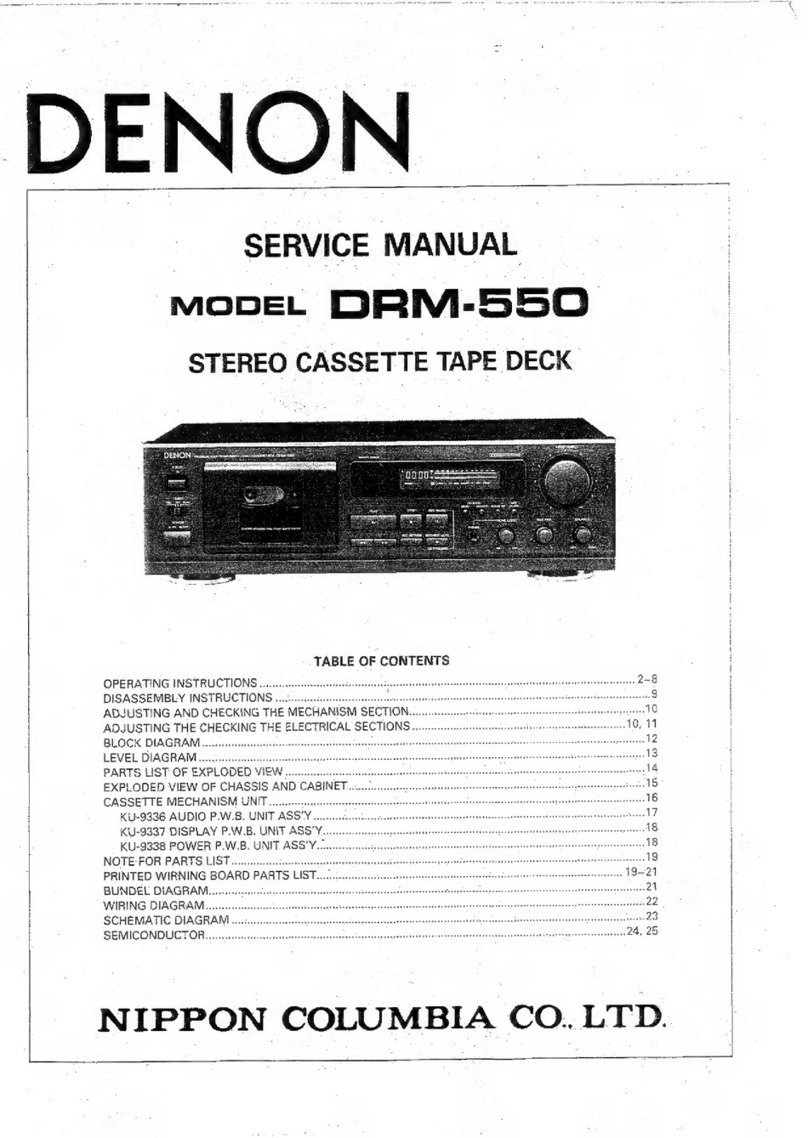
Denon
Denon DRM-550 User manual

Denon
Denon DRM-595 User manual

Denon
Denon DR-M2 User manual
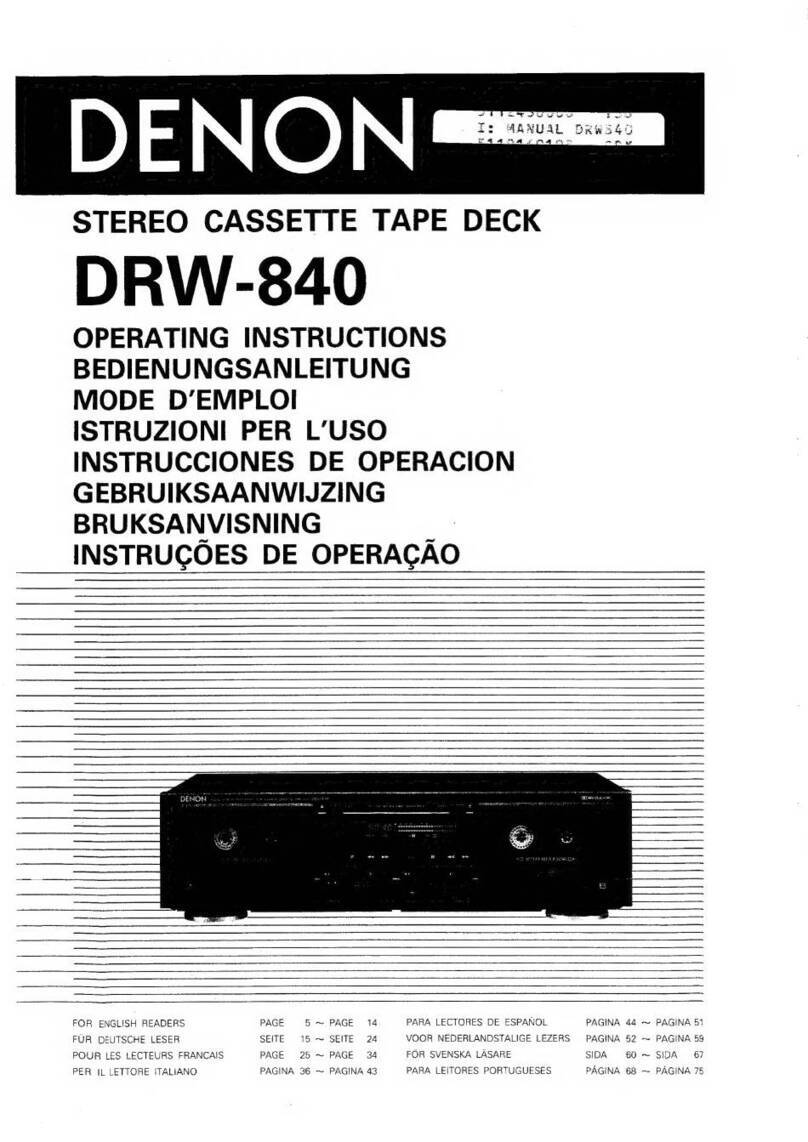
Denon
Denon DRW840 - Stereo Double Cassette Deck User manual
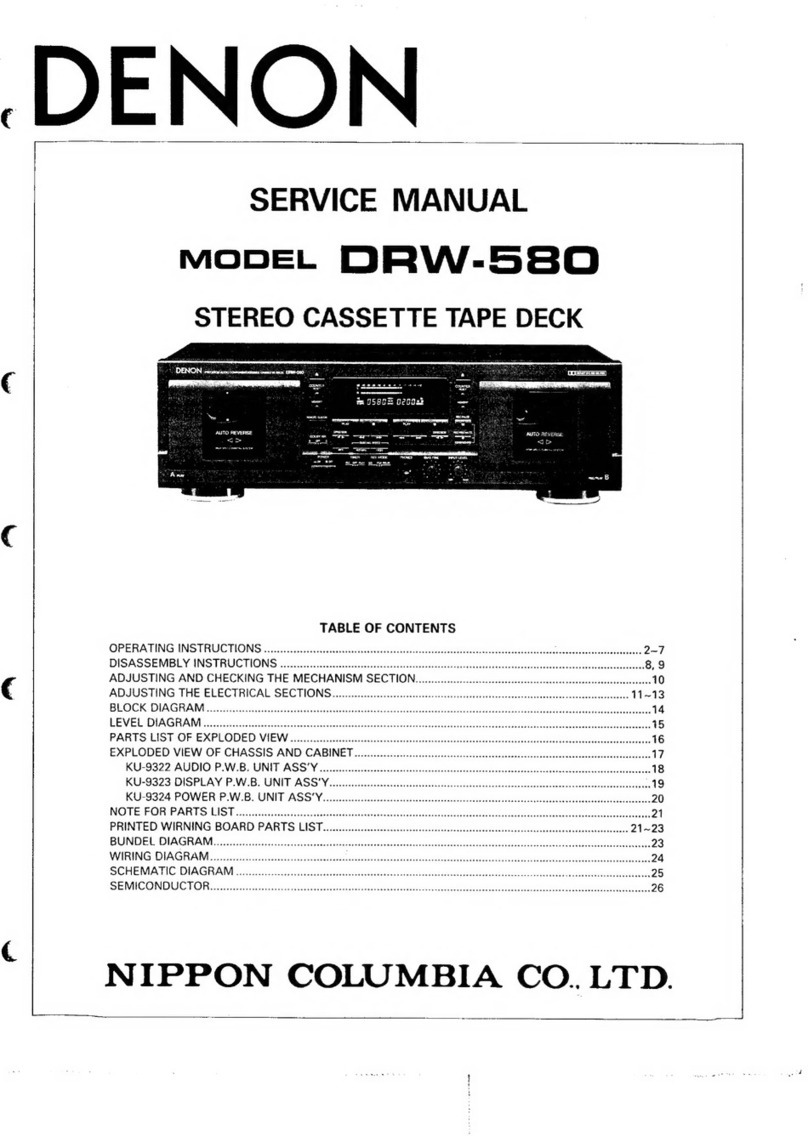
Denon
Denon DRW-5830 User manual
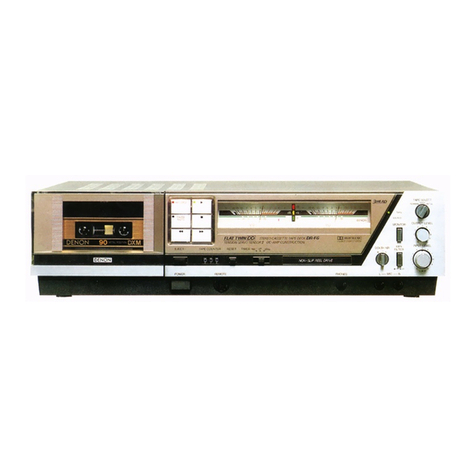
Denon
Denon DR-F6 User manual
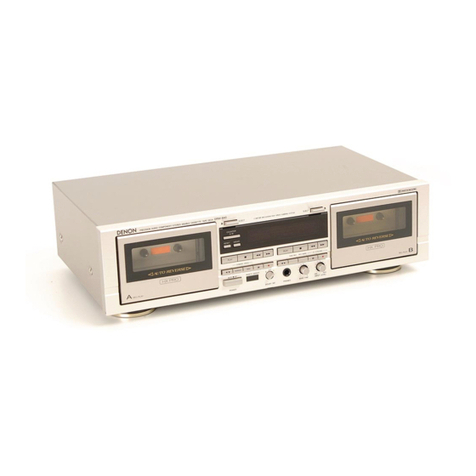
Denon
Denon DRW840 - Stereo Double Cassette Deck User manual

Denon
Denon DRW-585 User manual
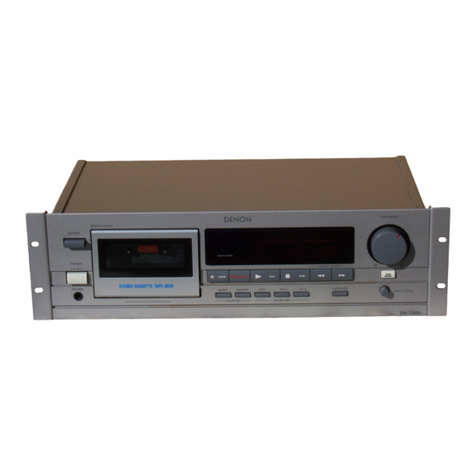
Denon
Denon DN-730R User manual


